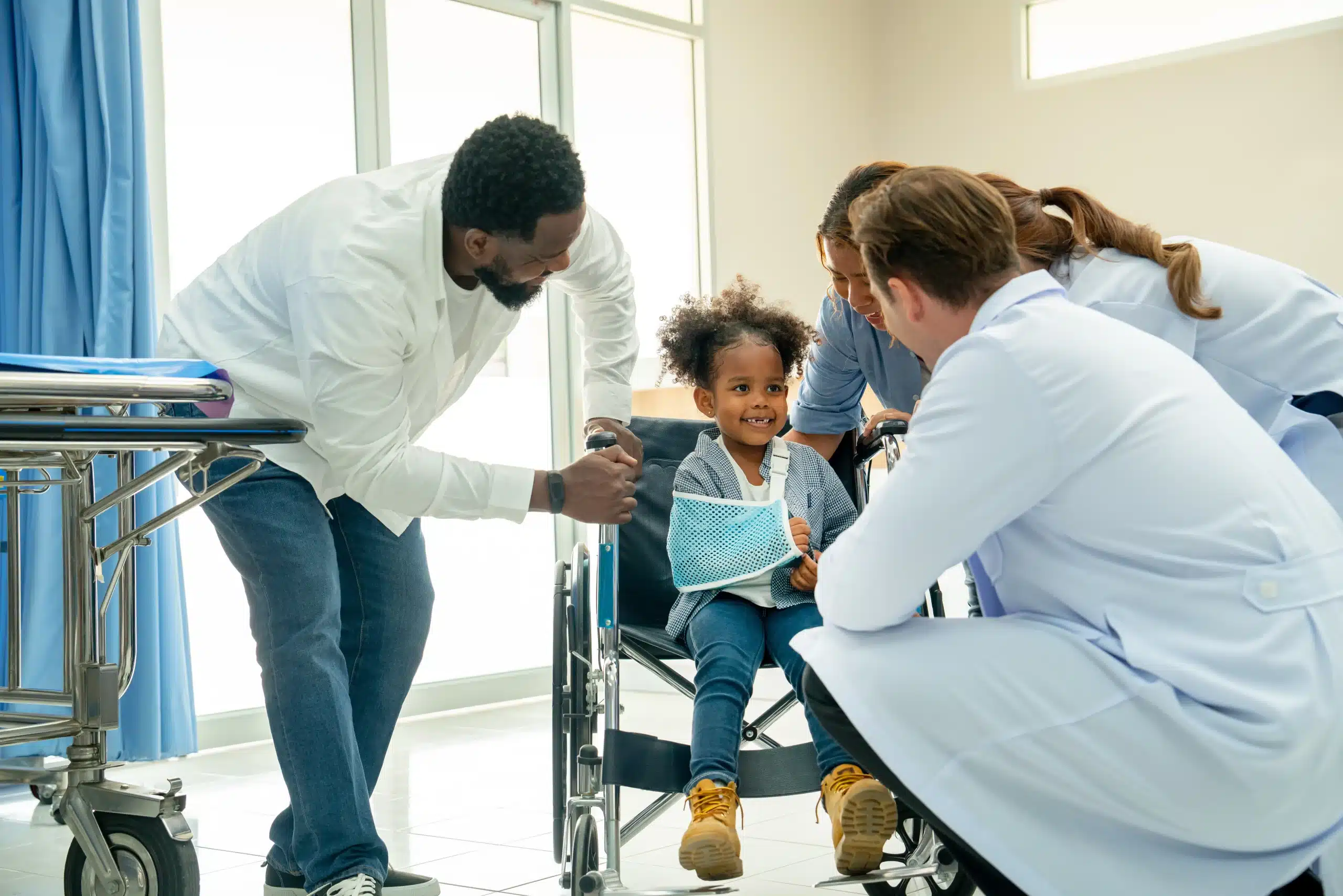IT'S MORE TO US, IT'S PERSONAL
Pursuing Justice For Child Injuries: Our Child Injury Lawyers Will Secure the Compensation Your Children Deserve
Contact a Wettermark Keith Child Injury Lawyer Today for a Free Consultation
Children are the heartbeat of a family - when they are seriously injured, the consequences can tilt a family's world off its axis. A loud crash, a sudden, piercing cry, the sharp gasp of a nearby adult - these are often the first indicators that something has gone seriously wrong. Other times, it's an ominous silence in a house normally filled with noise and laughter. Whether it's a short fall from a tree or a traumatic brain injury from a car accident, healing from a childhood injury often extends beyond visible bruises or scars.
Every 4 seconds, an injured child is treated in an emergency room. Falls, sports injuries, bike accidents, car crashes, near-drownings, poisonings, fires, and deliberate abuse are just a few of the ways in which children are physically hurt each year. Regardless of cause, emotional scars often run deeper than physical, and can reshape a child's interactions with their environment. Normal childhood activities - like riding a bike or playing soccer after school - may suddenly seem frightening and be avoided. Parents often find it difficult to cope with personality changes in a once-outgoing child, now made fearful, angry, withdrawn or sullen by psychological trauma. The shaken sense of safety that serious injuries induce can have profound, long-term impacts on a child’s continued development.
When a child is injured, parents experience an overwhelming mix of emotions - concern for the child, anxiety about medical expenses, anger at whoever is responsible, and uncertainty about long-term implications. We realize that witnessing your child struggle with pain, mobility limitations, embarrassment over scars or disabilities, grueling surgeries, and post-traumatic stress is incredibly heart-wrenching - and that the financial strain of treatment only compounds your stress and heartache.
That's where we come in.
When your child is injured by the negligence or dangerous choices of others - a drunk driver, abusive caregiver, poorly maintained playground, or defective product designer - the at-fault party must be held accountable. Though money can never undo the damage to your child or restore what is lost, securing fair compensation can reduce your financial burdens, freeing you to focus on supporting your child’s recovery. Our child injury lawyers can handle complicated investigations, negotiations with insurers, advocacy in the courtroom and any other legal actions necessary to obtain the compensation you and your child deserve.
Understanding Child Injuries
"Injury to a child" refers to any harm or damage inflicted upon a minor, whether intentionally or unintentionally. This harm can be physical, emotional, or psychological in nature. Physically, it can range from minor injuries, like cuts or bruises, to more severe traumas, like broken bones, burns, or internal injuries. Emotional or psychological injuries might result from instances of neglect, abuse, witnessing traumatic events, or being subjected to persistent harmful environments or interactions. From a legal standpoint, "injury to a child" can also pertain to deliberate actions or neglect by a caregiver, parent, or another individual that results in harm to the child. Laws across jurisdictions often carry specific definitions, penalties, and protective measures concerning child injury to safeguard the rights and well-being of minors.
To truly understand child injuries, you need to look at the different environments children frequently interact with and the inherent risks each presents. The home, for example, may harbor hidden dangers - a worn, slippery set of stairs, a kitchen counter with sharp utensils within reach, or even toys with small detachable parts that pose choking hazards. Beyond the home, schools and playgrounds, despite being designed for use by children, are not immune to accidents. Faulty playground equipment, rough play or bullying, a patch of ice, or a simple lack of supervision have led to countless child injuries.
While children can sustain injuries in a wide variety of ways, and the circumstances leading to each injury are unique, some causes of serious (or fatal) child injuries are more common than others:
Child Injuries at Home
Countless child injuries and accidents happen in the most familiar surroundings. Common sources of liability include:
Product Liability - whether the product in question is a toy, piece of furniture, or household item, if a product is defective in design or manufacturing and directly harms a child, those involved in bringing that product to market may be held liable. Proving these cases requires identifying precisely which entity was negligent and how. Retailers, distributors, manufacturers, parts suppliers, and designers might all share in liability.
Premises Liability - homeowners and landlords have a responsibility to properly maintain their properties and minimize risks to others. If slippery floors, faulty staircases, unsecured pools, or defective electrical wiring cause a child injury, the property owner may be deemed negligent.
Dog Bites - even friendly family pets can be capable of biting if provoked. However, if the dog has shown aggression before, the owners may be considered liable for any resulting injuries, depending on jurisdiction. The breed, size, and age of the dog often factor into these cases as well.
Poor Supervision - lack of adequate supervision is a factor in many household accidents involving children. However, who shoulders this responsibility depends on the circumstance. At times, it may extend beyond the parents to negligent caregivers or babysitters.
Medical Malpractice and Children
Doctors and healthcare professionals owe a sworn duty of care to the children they treat. However, negligence can take place at even the best hospitals. Common forms of medical malpractice that cause child injuries include:
Misdiagnosis - an inaccurate or delayed diagnosis can severely exacerbate a child’s condition. Certain pediatric conditions like infections and cancers tend to manifest differently than in adults, complicating proper diagnosis. Relying on obvious symptoms alone rather than running in-depth tests falls short of reasonable care.
Surgical Errors - from operating on the wrong body part to leaving surgical instruments inside patients, surgical mistakes occur more often than one might imagine, especially in more complex procedures.
Medication Errors - in busy pediatric hospital wards, there are instances where incorrect drug doses or medicines are administered to the wrong child. A misdiagnosis or incorrect dosing can have severe health implications on a child.
Birth Injuries - during the strain of labor and delivery, a doctor's poor decision making or negligence under pressure may cause harm to the infant. Common birth injuries include broken bones, nerve damage, and oxygen deprivation.
School and Playground Child Injuries
Schools and playgrounds are typically safe places of learning, recreation, and play. However, they aren’t without risks, even when reasonable precautions are taken. Common causes of injury in these settings include:
School Bus Accidents - jolting school bus rides or driver negligence - such as speeding, distracted driving, and disobeying traffic rules - can lead to injury. The school district, bus driver, and even auto manufacturers may bear responsibility for a child's injury on a school bus.
Playground Equipment Accidents - faulty, rusted playground equipment, worn swing sets and slides, and lack of proper surface padding can result in fractures, head trauma, and other injuries.
Physical Education Injuries - lack of supervision or safety equipment and inadequate student training on sports safety can turn a typical P.E class into a nightmare. Liability for an injury in a physical education class may fall on both schools and teachers.
Bullying and Physical Harm - schools have a responsibility to implement policies against bullying and ensure staff intervenes appropriately if students are being victimized. Failure to do so can make the school liable for any psychological and physical injuries.
Field Trip Injuries - when they're a part of the school curriculum, injuries during field trips typically mean the school was responsible for exercising due care and supervision, and failed to do so. However, venues like museums and parks also need to take reasonable precautions to avoid liability.
Premises Liability Injuries Involving Children
Property owners have a legal responsibility to ensure reasonable care is taken to minimize known premises risks, especially to vulnerable groups like children. If a lapse in care leads to a child getting injured, premises liability laws enable holding the property owner accountable. Our firm has successfully handled premises liability cases involving:
Inadequately Secured Construction Sites - children are often drawn to the noisy machinery and activities of construction areas. These sites must be appropriately fenced off and signed to prevent unauthorized child access where dangerous conditions may exist. Failure to do so can lead to serious injuries, or even death.
Poorly Maintained Playgrounds - schools, daycare facilities, apartment complexes, and parks must regularly inspect the play equipment on their grounds. We have seen cases where broken seesaws, worn swing set bearings, cracked slides, and exposed concrete footings led to head trauma and broken limbs. Routine maintenance helps avoid injuries.
Negligent Pool Supervision - Public and community pools located at apartments, gyms, recreational centers, and hotels must have certified lifeguards actively supervising swimmers. If their inattentiveness allows a child to slip under water unnoticed, devastating injuries may result.
Trip and Fall Hazards - cracked sidewalks, loose handrails on steps, pathways cluttered with debris, and other tripping dangers can cause children to suffer serious fall injuries. Property owners have a responsibility to address these hazards.
Dog Bites - while pets should generally be leashed and supervised when outdoors, indoor pets can also bite if provoked in some way, or if their prey drive is triggered by a small child. If a property owner knew their dog had a tendency for aggression but failed to inform guests or take adequate precautions, they share in liability for a bite injury.
Auto Accidents and Child Injuries
A child's size and bone density makes them far more susceptible than an adult to severe injuries in an auto accident. When a child suffers an injury in a car crash, liability factors for drivers involved might include:
Reckless Driving - Speeding, improper turns, running red lights, and driving while impaired dramatically magnify the risks. Holding negligent motorists fully accountable is key.
Seat Belt Misuse - failing to properly belt children in age-appropriate restraints or use booster seats can cause them to be ejected in crashes, putting them in mortal danger.
Vehicle Defects - auto part makers bear responsibility if defective vehicle parts prove to have caused or worsened injuries. Our firm has access to specialized experts to assess these defects.
Road Hazards - government agencies must address risks like potholes, inadequate lighting, malfunctioning traffic signals, and obscured signs that increase crash risks and injuries.

Steps to Take After a Child’s Injury
In the chaos following a serious injury to your child, it can be difficult to know what to do. Having an action plan and assistance from a child injury attorney helps. Important first steps include:
This is the top priority after any serious injury. Call 911 or bring your child to the nearest hospital immediately to receive urgent care from doctors. Stabilizing your child's injury quickly can drastically improve their outcome.
If possible, take photos and video of where the injury occurred and factors that may have contributed, like defective equipment, unsecured areas, spilled liquids, etc. These may be critical for determining liability later on.
For incidents in public areas or that involve vehicles, ask the police to come on-site and make a formal report to have an official record of what transpired.
Notify your health insurance company about the injury so they are aware of upcoming claims for medical expenses and can confirm what will be covered.
Retain all receipts and documentation related to medical bills, prescriptions, therapy appointments, equipment rentals, etc. A clear record of injury-related costs helps if you seek compensation later.
Contact one of our experienced child injury attorneys as soon as feasible to understand your legal options and protect your family’s rights.
Carefully follow all prescribed treatment and therapy instructions to help your child recover optimally. Keep attending scheduled follow-ups.
Get contact details of anyone who saw the accident firsthand. Their accounts could help establish what happened and where culpability lies.
Keep defective products or photographs of unsafe property conditions to have evidence, which may be critical if you pursue legal action later.
Insurance companies may pressure you for an official recorded statement soon after the injury. Avoid providing one before discussing with an attorney.
Frequently Asked Questions
Any harm causing damage or impairment to a child's physical health or normal functioning constitutes an injury. Child injuries can range from mild scrapes and bruises to more severe, life-altering traumas. They can stem from accidents, defective products, abusive acts, motor vehicle crashes, inadequate supervision, and medical negligence. If the injury results from provable negligence or misconduct, the injured child and their family may have legal options to pursue compensation through civil action.
Due to their minor status, children cannot initiate legal action on their own behalf. Instead, a lawsuit related to their injury needs to be filed either by their parents, legal guardians, or a court-appointed guardian ad litem specifically designated to represent the child's interests. However, the suit is pursued for the benefit of the injured minor, and any monetary compensation belongs to the child. Upon turning 18, the child gains legal standing either to take over the case from their guardians or to retain new representation.
Parents are not automatically liable for wrongful acts their minor children commit which cause harm to others. However, exceptions exist where the parents may bear shared civil liability or owe compensation. This includes situations where inadequate parental supervision or control directly contributed to the child's behavior. Parents can also be liable for damage caused by a child wielding a dangerous item, such as a gun or knife, that the parents made accessible.
If a child is harmed due to provable negligence on the part of the school, district, or employees, the injured student and parents may have a premises liability or general negligence claim against them. Many schools have insurance coverage for such situations. However, government-run public schools are usually protected by "sovereign immunity" laws capping recoverable damages. There are nuances based on whether negligence is by a teacher, administrator, or the board. Outcomes also depend on the duty of care owed to the child and nature of the negligent act.
Yes, parents have separate legal rights even if divorced. Either parent can file a suit on behalf of their injured child to seek damages for medical costs and other injury-related expenses. This applies to the custodial as well as the non-custodial parent. However, disputes may arise between parents regarding control over the case, allocation of proceeds, etc. Typically, the parent with primary physical custody will make legal decisions for the child unless otherwise stipulated in a divorce decree. For contentious cases, a neutral guardian ad litem may be appointed by a judge to represent the child’s interests.
Is a Child Injury Claim Different Than a Typical Personal Injury Claim?
Child injury claims have unique aspects that set them apart from a standard personal injury case. Some of these differences include:
An extended time period - because the injured person is a minor, damages like loss of future income and healthcare costs must be projected out and calculated over a lifespan vs just a few years.
Greater levels of caution - extra care must be taken to avoid further traumatizing a child when eliciting information, having them testify, or exposing details of their injury.
A different statute of limitations - depending on the state where the injury occurred, the statute of limitations will differ for minors compared to legal adults. In some states, the clock to file a claim starts ticking when the minor turns 18, while in other states, the statute of limitations is extended to give the parents or legal guardian more time to file.
Guardianship issues - since minors cannot directly sign legal contracts, the case either needs to be pursued by a parent/guardian on their behalf or have a guardian ad litem assigned by the court.
The sympathy factor - judges and juries naturally feel greater empathy and are more disposed to rule favorably when the victim is an innocent child.
Necessary expertise - these cases routinely demand input from vocational experts, healthcare specialists, life-care planners, economists, and other seasoned consultants when building a claim.
Impact on government benefits - compensation from a legal case can offset or complicate obtaining assistance from the government. Some government benefits, such as Medicaid and SSI disability benefits, are based on income and assets. If a child receives a large settlement or award in a personal injury lawsuit, it may make them ineligible for these benefits.
What Is the Statute of Limitations for Child Injury Claims?
The statute of limitations establishes legal deadlines by which a personal injury lawsuit must be formally filed or the claim is barred. For cases involving injured minors, some unique rules and exceptions apply compared to the time limits governing legal adults' claims. In most states and jurisdictions, the "clock" governing the statute of limitations does not start counting down right away as it would for an adult plaintiff. For child injury claims, it typically only starts running when the minor becomes a legal adult at age 18. From there, the timeline to file a lawsuit often ranges from 2-4 years in many states. However, some states allow an even longer window - such as 7-10 years - if the plaintiff was a minor at the time of injury.
The key is that the clock stops ticking if a legal case is opened before the deadline passes in that particular state. This preserves the child's ability to have their claim heard. However, if the window lapses, the right to sue is generally forfeited even if the plaintiff was a minor at the time of injury. However, the intricacies of child injury statutes of limitations vary between states. Our experienced child injury attorneys understand these nuances, and can ensure no deadlines are unintentionally missed. Consulting a knowledgeable lawyer as early as possible after an incident, even if a child is very young, ensures you know exactly how long you have to file a claim should you choose to do so. Never rely on generic personal injury time limits, as the rules for children add complexity.
Hire an Expert Child Injury Lawyer Today
The physical, emotional, and financial consequences of a child injury can be enormous. Severely injured children may require multiple surgeries over many years, suffer permanent disabilities, and struggle with basic daily activities and long-term emotional damage. After a child is injured, a legal process often begins to determine accountability and secure the compensation needed to cover damages. The expertise of a qualified child injury attorney is crucial at this stage. Without proper legal representation or knowledge of the complexities involved in a civil lawsuit, families may settle for far less than their case is worth - or even walk away with nothing. So why hire a child injury lawyer? Put simply, a skilled child injury lawyer levels the playing field and handles all legal complexities on a family's behalf. Our child injury attorneys know how to thoroughly investigate liability, prove negligence, establish damages, negotiate with skill, and if necessary, take a case to trial. You and your child deserve both justice and compensation, and we will do our best to ensure you receive it.
Don't hesitate - call Wettermark Keith at (877) 715-9300 for a free consultation with our legal team. We realize you may be in a difficult financial situation. In light of this, we handle cases on a contingency fee basis, meaning you pay nothing upfront or out of pocket. If your attorney does not win your case, you will owe us no legal fees for our services.
Wettermark Keith, with offices located throughout Alabama, Tennessee, and Florida, has an excellent reputation as one of the most accomplished personal injury firms in the country. Our reach is not only regional but includes a diverse range of practice areas, including premises liability law, personal injury cases, auto wrecks, trucking wrecks, nursing home abuse, medical malpractice, on-the-job injuries, social security disability, and veterans’ disability claims, to name just a few. At Wettermark Keith, we believe in taking cases personally. Our purpose is to practice with care and compassion- to tell our clients’ stories and make their voices heard. We do this by building strong relationships based on constant communication and an unwavering dedication to truth and trust. You should never wonder what’s going on with your case. We will keep you in the loop and represent you as if you are family- because to us, you are.




